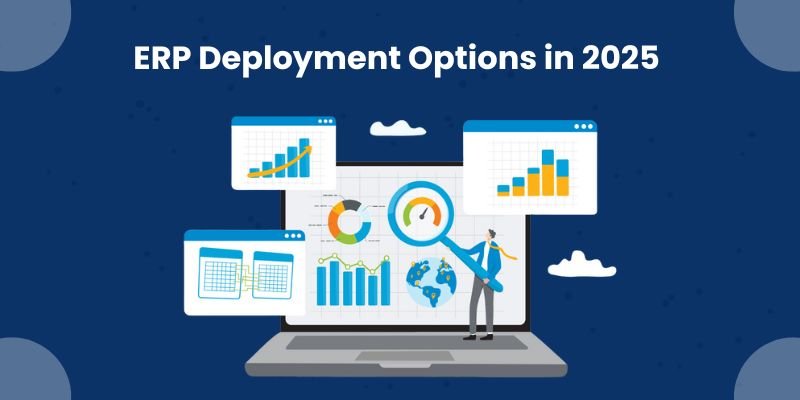ERP systems remain important for business effectiveness. As 2025 approaches, companies change their ERP implementation strategies. They respond to changing business demands, quick technological growth and strict rules. This text looks at ERP deployment choices. On-premises cloud, hybrid as well as industry-specific solutions are examples. It also checks elements that affect deployment choices and points out new developments. It provides answers to shared questions. Examples are “Cloud versus on-premises ERP” and “What comprises a hybrid ERP system?” This support helps leaders pick the best strategy.
In order to stress ERP deployment, ERP implementation strategies, Hybrid ERP solutions along with future ERP deployment trends, this guide intends to show a balanced point of view. This helps with selecting an ERP system. This system should satisfy both present needs besides future expansion.
Overview of ERP Deployment Options
Organizations now have multiple ERP deployment options to consider, each offering distinct benefits and challenges. The landscape includes on-premises, cloud-based, hybrid, and industry-specific solutions designed to suit varying business models.
On-premise ERP solutions
On-premise ERP solutions are based on older technologies that use an organization’s internal servers and infrastructure.
This model provides complete control of the ERP ecosystem, which is helpful for organizations with stringent data security, compliance, and customizable workflows. An organization’s business processes can easily be met without restriction by preset vendor frameworks through on-premises ERP.
At the same time, this control tends to be expensive. On-premises solutions generally require significant capital outlays for hardware, software licensing, and IT staff. Furthermore, the returns tend to meet proprietary-maintained resource relationship systems that are intensive in maintenance, upgrades, and scalability – when compared to cloud or hybrid systems.
Cloud-based ERP solutions
Cloud-based ERP solutions are hosted on third-party servers and accessed via the internet, giving businesses a flexible and scalable option compared to traditional systems.
This model significantly cuts down on upfront costs since there’s no need to invest in physical infrastructure or extensive in-house IT support. Instead, companies pay a recurring subscription fee, which usually covers updates, maintenance, and customer support. With cloud ERP, teams can access real-time data from anywhere, making it perfect for remote work and fast-paced environments. Plus, automatic updates keep the system up-to-date with the latest features and security patches.
However, relying on internet connectivity can lead to performance issues, and some businesses are still hesitant about storing sensitive information offsite. Navigating regulatory compliance can also be a challenge, especially when data is spread across different jurisdictions, which means careful vendor selection and contract negotiation are essential.
Hybrid ERP solutions
Hybrid ERP solutions strike a balance by combining both on-premises and cloud-based systems, allowing organizations to customize their ERP deployment based on specific operational and regulatory requirements.
This approach lets companies keep critical or sensitive data on local servers while moving less sensitive functions—like HR, CRM, or procurement—to the cloud. Hybrid ERP is especially appealing to businesses looking to modernize gradually, minimizing disruption by introducing cloud capabilities without completely abandoning their existing infrastructure. It also offers the flexibility to adapt the deployment model across various departments or locations.
However, the dual nature of hybrid systems can add complexity, particularly when it comes to integrating data flows and ensuring synchronization between cloud and on-premises environments. Managing costs can also be a bit tricky, as organizations might face expenses from both deployment types while also investing in tools and talent to keep everything running smoothly.
Industry-specific ERP solutions
Industry-specific ERP solutions are crafted with the distinct needs of various sectors in mind. They come equipped with ready-made modules and workflows tailored for industries such as manufacturing, healthcare, retail, and education.
This thoughtful design helps streamline the implementation process by cutting down on the need for extensive customization, as these systems are already in sync with industry standards and compliance requirements. Organizations enjoy the perks of quicker deployment, less configuration time, and the advantage of vendor expertise that understands their unique operational challenges. Plus, support teams often possess industry-specific knowledge, which means they can resolve issues faster and provide more relevant guidance.
However, this specialization can sometimes limit flexibility, making it tricky to adapt the system to unconventional or rapidly evolving business models. There’s also a greater reliance on the vendor for updates, support, and long-term compatibility. In some instances, these targeted solutions can come with a higher price tag, which might strain budgets—especially for smaller organizations or those operating on tight profit margins.
Factors That Influence Your Deployment Choice
When it comes to picking the right ERP deployment option, it’s all about finding the right mix of financial, operational, and technological factors. Grasping these elements is crucial for making sure your ERP strategy aligns perfectly with your business goals.
Cost Considerations
Cost is a major player in this decision. On-premises systems usually demand a hefty upfront investment in hardware, software, and IT staff.
On the flip side, cloud-based solutions turn expenses into a more manageable operational model with predictable monthly or annual fees. Hybrid models often require a thoughtful assessment of both types of investments. When looking at long-term costs, don’t forget to factor in maintenance, upgrades, and potential downtime to ensure that your overall return on investment truly meets your business needs.
Scalability Needs
It’s essential for businesses to choose ERP solutions that can grow alongside them. Cloud-based systems are inherently scalable, allowing for quick adjustments in user capacity and functionality.
In contrast, scaling an on-premises solution might mean investing in additional hardware and facing longer deployment times. The ability to scale effectively is vital for companies that expect rapid growth or shifts in the market.
Security and Compliance Requirements
For industries that have to adhere to strict regulatory standards, data security is non-negotiable. On-premises systems provide direct control, making them a go-to choice for organizations with high compliance needs.
However, today’s cloud ERP providers have made significant strides in security, offering features like encryption, multi-factor authentication, and continuous monitoring. Hybrid solutions can strike a balance by keeping sensitive data on-premises while utilizing the cloud for less critical processes.
IT Infrastructure and Resources
When it comes to deploying ERP systems, an organization’s current IT infrastructure and the expertise of its internal team play a huge role.
Companies that have strong IT departments and sophisticated on-premises setups might lean towards traditional ERP systems. On the other hand, businesses with fewer IT resources could find cloud ERP systems more beneficial, as these options come with managed services that lighten the load of daily maintenance.
Business Agility and Innovation
In our fast-paced business world, being agile is essential. ERP solutions that can swiftly adapt to emerging technologies—like artificial intelligence (AI) and machine learning—empower companies to innovate and maintain their competitive edge.
Typically, cloud-based and hybrid ERP systems are better suited for quick updates and integrations, ensuring that the ERP system remains aligned with changing business strategies.
Emerging Trends in ERP Deployment
The world of ERP is changing, and several key trends are reshaping how organizations deploy these systems:
Increased Adoption of Cloud Solutions
More and more organizations are turning to cloud-based ERP solutions because they’re cost-effective, scalable, and easy to update. This cloud approach helps businesses cut down on capital expenses while boosting flexibility and allowing for remote access.
Integration of AI and Machine Learning
We’re seeing AI and machine learning being woven into ERP systems to take care of routine tasks, streamline supply chain management, and enhance predictive analytics. These advancements not only lighten the manual workload but also provide decision-makers with real-time insights that can really make a difference.
Focus on User Experience and Mobility
Today’s ERP systems are all about user-friendly interfaces and mobile access, making it easy for employees to engage with the system from any device. By prioritizing a better user experience, organizations can boost engagement and ensure a smoother transition to new features, which is especially crucial in a hybrid work setting.
Data-Driven Decision Making
ERP systems are changing the game by offering more in-depth data analytics and real-time dashboards. This advancement allows organizations to keep an eye on their performance, predict future trends, and make well-informed strategic choices, highlighting just how crucial ERP is for overall business intelligence.
Enhanced Integration and Customization Capabilities
As businesses juggle a mix of old legacy systems and new technologies, the need for seamless integration has never been more important. Today’s ERP solutions come with modular architectures that make customization and integration with specialized applications a breeze, ensuring the system grows and adapts with the evolving needs of the business.
FAQs
What are the main ERP deployment options available in 2025?
In 2025, organizations have a variety of choices for ERP deployment, including on-premises, cloud-based, hybrid, and industry-specific solutions. Each option comes with its own set of advantages, particularly when it comes to cost, customization, and scalability.
How does cloud ERP differ from on-premises solutions?
Cloud ERP operates on remote servers and usually follows a subscription model, which helps lower initial costs and boosts scalability. On the other hand, on-premises ERP is installed directly on local systems, giving businesses more control over their data and customization options, but it typically requires a larger upfront investment.
What is a hybrid ERP system?
A hybrid ERP system merges aspects of both on-premises and cloud deployments. This allows organizations to keep sensitive data stored locally while still taking advantage of the scalability and flexibility that cloud services offer.
What factors should be considered when choosing an ERP deployment method?
When selecting an ERP deployment method, it’s important to consider several key factors, including cost, scalability, security and compliance needs, existing IT infrastructure, and the overall agility of the business. Each organization should evaluate these elements based on its specific operational and strategic requirements.
Are cloud-based ERP systems secure for educational institutions?
Absolutely! Many contemporary cloud ERP providers implement strong security measures, like encryption and multi-factor authentication, making them a good fit for educational institutions. However, it’s essential to check that each provider complies with the necessary data protection standards.












